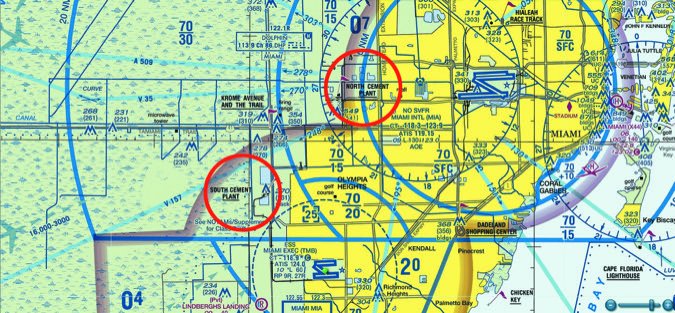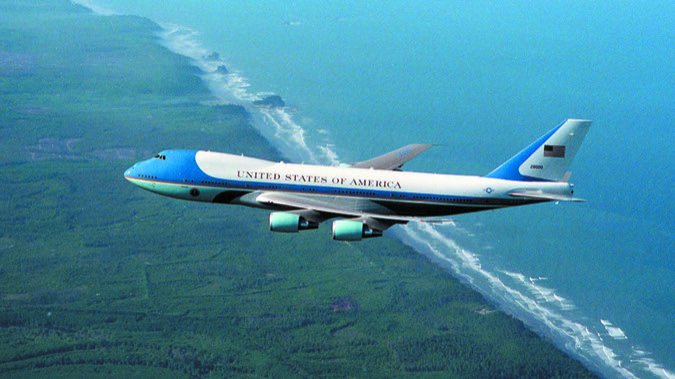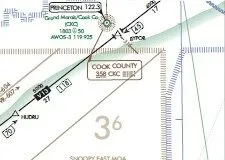I was southbound on a solo cross country flight before getting my license, returning to Miami Executive Airport (KTMB). The ceilings and visibility were dropping and I was down to about 1500 feet over the Everglades swamplands. I navigated using roads and other VFR checkpoints, which were getting harder to see out the Cessna 172’s windshield.
One of those checkpoints was a huge cement plant. On the way out, it had been on my right. Considering I was taking the same route back, it should have been on my left. It wasn’t. Looking ahead, it was to my right again, steam and smoke pouring out from its stacks as before. Not only did this mean I was off course, it meant—oh crap!—I’d violated Miami International Airport’s Class B airspace block!
I firewalled the Cessna’s throttle and pedaled west as fast as I could. Thoughts of paperwork and FAA FSDO investigations filled my head. Channeling some Hitchhiker’s Guide to the Galaxy—”Don’t panic…”—I took a breath and looked at my sectional chart again, and cross-referenced it with what I was seeing outside.
My pulse slacked off. I’d forgotten there were two cement plants—north and south—about six miles apart. The one I’d just seen was the south one, which was well outside KMIA’s Class B. Both plants were located on the boundary between civilization and swamp. I flew right past the north one and never saw it. I’d succumbed to the low visibility, the similarities between both plants, and, of course, my own inexperience.
That scare taught me just how quickly an airspace bust can happen. Now, working as an air traffic controller, airspace violations are something I need to defend against daily. How can you keep from becoming a statistic?
Are You Talking to Me?

Avoiding Class B, C, or D airspace doesn’t seem that hard. Many modern cockpits present their occupants with an enormous amount of information, including electronic warnings when the aircraft approaches controlled airspace. Even if you’re just using a sectional and VFR landmarks, those invisible walls in the sky are usually pretty easy to avoid as long as you—ahem—spot the correct landmark.
However, many violations occur when pilots are actively trying to enter specific airspace. Let’s briefly return to ground school and discuss communication requirements. Entering Class B airspace requires a clearance from ATC. Without a controller explicitly telling you, “cleared into the Class Bravo airspace,” stay away. That’s pretty cut and dry.
Where we hit some grey area is entry into Class C and D airspace. Both feature the same communications requirement in AIM 3-2-4 and 3-2-5: “Two-way radio communication must be established with the ATC facility providing ATC services prior to entry and thereafter maintain those communications while in Class C/D airspace.” The grey area, of course, is knowing exactly what “two-way communications” means.
Imagine you want to land at my Class C airport. You were out in a practice area, VFR, and not talking to ATC. You dial in my frequency. “Regional Approach, Cherokee Six Alpha Bravo is 20 miles north of Regional Airport, requesting a full stop landing.”
I’m working that radar sector and was in the midst of coordinating with another controller. I caught the last part of your transmission, but not your call sign. I still need to do some more coordination for another plane, but I want you to know I heard you. “Aircraft calling twenty miles north of Regional Airport for a full stop, standby.”
I go about my business. You continue trucking towards Regional Airport. Minutes pass. In the midst of other duties, I don’t get back to you. So, here’s the question: are you authorized to enter the Class C? I mean, I did respond to your transmission, right? Is that two-way communication?
The answer? Nope. Unless ATC uses your specific call sign, it’s not considered two-way communications. Think about it: there could have been another aircraft, also twenty miles north of Regional and inbound to land. They may have been on a different frequency, where you couldn’t hear them. Therefore, you cannot definitively say my “standby” response was directed at you, unless I’d said, “Cherokee Six Alpha Bravo, standby.” It’s an important distinction.
Defensive Driving
Let’s say I did use your call sign in my response. It’s standard practice for us to tack on the following: “Remain outside Class Charlie and Delta airspace, and say request.” We’re fully aware that if we say your call sign, you can just come on into our Charlie or Delta airspace. We don’t want you doing that until we’ve established your position and your request. It’d be like inviting a stranger into your home without knowing who they are or what they want.
Not complying with that can lead to some, err, interesting situations. I was up in a Class C airport’s tower a few years back, working Ground while a trainee was receiving instruction on the Tower side. He and his instructor were contending with a pattern and a variety of arrivals. Out of nowhere, a strange Cessna 172 called them up in the downwind, requesting to land. There was a bit of commotion as they figured out who he was and worked him into their sequence.
Apparently, the Cessna had called Approach 25 miles northwest. Approach told them to both squawk a particular transponder code and “remain outside Class Charlie airspace until advised.” Well, first, it turned out the pilot’s transponder was busted. Without that, the radar wouldn’t “tag” the target with the call sign, aircraft type, and so on. Second, Approach missed the no-transponder, primary-only target cruising into our airport.
The aircraft was never radar-identified (i.e. no “radar contact”). In fact, after issuing the squawk code and “remain outside…” the controller never spoke to that aircraft again. That should’ve told the pilot that something was off. Ideally, prompting him to call ATC and verify they were permitted to enter the Class C. Instead, the pilot just slipped into the traffic pattern, called Tower, and gave my coworkers an unpleasant surprise. While the controller caught some heat for missing the target, this was flagged as a pilot deviation since the pilot didn’t comply with the “remain outside” instruction.
Controllers get stung too. A buddy working radar got a call from a local Mooney pilot who knew the “two-way communication” rules very well. My friend used the Mooney’s call sign when telling him to “standby” after the initial call, forgot to tell him to remain outside the airspace, and got distracted by other traffic. Well, the Mooney sauntered right on into the Charlie, legally. It definitely left an impression on my friend, though. Yep, each scare is a lesson.
Just use common sense. If you’re approaching a tower environment, and you’re not certain that ATC knows where you are or has approved your entry, verify it. Between human factors and technological failures, be the link in the safety chain that remains unbroken. Make sure you’re all on the same page.

Riding the Line
On the common sense note, I’d like to stress that legal doesn’t always mean safe when it comes to airspace. That may sound bizarre, considering how many regulations the FAA imposes on both pilots and air traffic controllers, but it’s absolutely true.
One day, I was running a sequence of airliners into a Class C airport. Ours was a pretty typical Class C: an internal ring extended five miles from the airport—surface to 4300—and the outer ring from 5 to 10 miles, 1500 to 4300 AGL. On this particular day, the ceiling was broken at 2000, so we were running ILS approaches.
An unidentified target crept in from the north, squawking VFR. His altitude bounced between 1000 and 1400 feet. This guy proceeded to park himself just outside a five-mile final for our active runway and do 360s. The FAF for our ILS was 1500. He couldn’t have picked a worse place.
I issued traffic to my first airliner, a 737, who’d already been cleared for the approach. “Traffic, eleven o’clock, two miles, maneuvering, altitude indicates 1400.” The crew got the guy in sight and ended up swerving their planeload of passengers around it. They were nearly close enough to read the tail numbers. As I brought in other airliners, I issued many traffic calls to them and tried to time their approaches with this guy’s 360s. Shortly thereafter, the aircraft moved out of the way.
Now, this pilot was legal. He was below the 1500-foot Class C outer ring at 1400 feet, and outside the five mile inner ring. Being VFR, he was also supposed to “see and avoid” other aircraft. However, he created considerable worry and workload for the airline pilots and for me. My biggest concern was one of the airliners’ TCAS—Traffic Collision Avoidance System—triggering and forcing the airliner to go around. TCAS is very sensitive, and a randomly maneuvering aircraft only 100 feet below their flightpath was a surefire problem.
We tracked the target to a neighboring airport, called their tower as he was landing, and asked them to have the pilot call us. The pilot said, “I didn’t know I was in a bad place until that Boeing [737] buzzed me.” He apologized. He’d been flying along and got distracted by some outdoor concert on the ground. Our supervisor advised him that he was not legally required to be talking to ATC where he was flying, but it would have been a really,reallygood idea from a safety aspect.
Following the Breadcrumbs
Airspace violations are, unfortunately, a fairly common occurrence. Some are just an “oops,” where the pilot lost situational awareness and wound up on the wrong side of the line on the chart. Others, well, might be intentional.
For example, Class C airspace requires that aircraft flying above it, up to 10,000 feet, must have an operable Mode C transponder. One pilot was orbiting at 5000 feet over the Charlie, and apparently wanted to get down below the outer shelf in a hurry. He shut off his transponder, so we lost his altitude readout, but still had his “skin paint” primary radar track. A minute later, when he reengaged his transponder, it was showing 1300 feet, underneath the outer shelf. He thought he was being slick, but we knew exactly what he was doing. We tracked him down.
Pursuing a violator isn’t difficult for us. We can initiate a track on any target and locate its origin point via radar playback. If it leaves our airspace, we can communicate with neighboring facilities and have them advise us when and where the airplane lands. If it lands inside our airspace, we have landlines to all the control towers in our airspace and phone numbers for airport managers and FBOs at non-towered airports.
If an aircraft is equipped with an ADS-B “out” transponder it makes tracking down the violator easier. An aircraft’s ADS-B broadcast includes the aircraft’s registration number. With just a few keystrokes, we can display it and log it if needed, even if the airplane is squawking VFR.
Violators aren’t uniquely civilians. One cruised right through my old Class C tower’s inner ring. I whipped out my binoculars and identified the aircraft as a type unique to a military squadron located at a nearby base. I notified my radar buddies. They initiated a track. The aircraft flew through a nearby Class D airport’s airspace without talking to them either and, sure enough, eventually landed at the base. Their squadron commander got a very spirited phone call.
Despite all the above, I certainly don’t want it to sound like we’re conducting witch hunts. Controllers loathe paperwork and aren’t out to ruin anybody’s day. However, airspace definitions exist to help keep aircraft separated. If someone isn’t respecting those boundaries, it’s a real hazard to safety and the overall flow of our traffic. If we don’t do something the first time, it might happen again, and might become an accident statistic.

As mentioned in the article, we have ways of tracking violators to their landing point. Normally, we solicit a phone call from the pilot, collect their information, and forward the incident paperwork up the FAA management chain. From there, FAA investigators examine the circumstances, likely interview the pilot, and determine corrective action. Whatever happens usually takes place long after the plane has landed.
A VIP TFR is a vastly different animal. If a VIP TFR is in effect, a U.S. Secret Service agent will be in the radar room, observing the proceedings, ready to call in support. If someone busts the TFR, it isn’t just a phone call and a waiting game. The unlucky pilot may instead find himself being intercepted by armed combat aircraft, and find Secret Service agents or other law enforcement officials awaiting his arrival.
What happens from there? Possible prison time, fines, and/or license suspension or revocation. Visit https://jrupprechtlaw.com/tfr-violation for a sobering look at what can happen. Check your NOTAMs, update your apps, get those briefings, and make sure you aren’t flying straight into trouble. —TK
Tarrance Kramer’s seen one too many pilots treat those invisible sky walls like open windows while working traffic in the Midwest.





